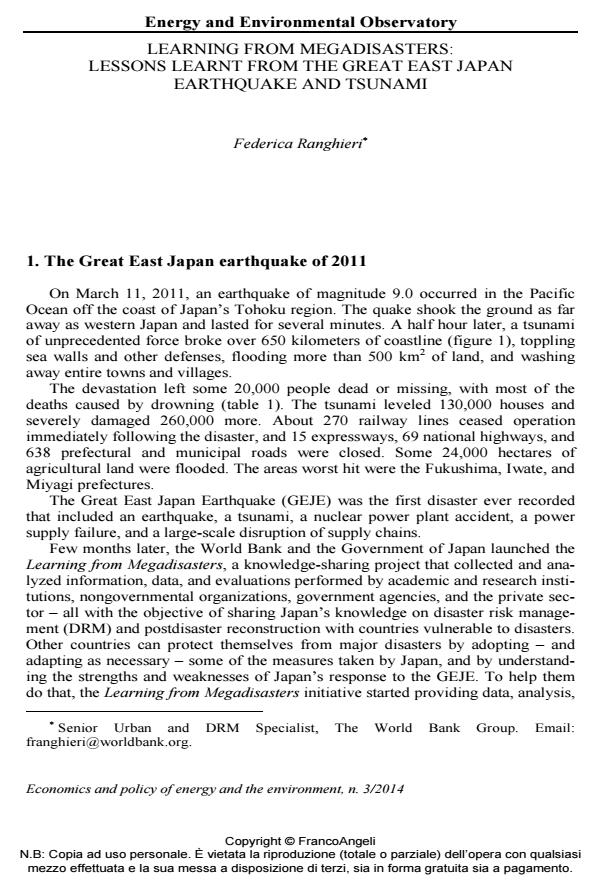Learning from megadisasters: lessons learnt from the Great East Japan earthquake and tsunami
Titolo Rivista ECONOMICS AND POLICY OF ENERGY AND THE ENVIRONMENT
Autori/Curatori Federica Ranghieri
Anno di pubblicazione 2015 Fascicolo 2014/3
Lingua Inglese Numero pagine 13 P. 5-17 Dimensione file 1076 KB
DOI 10.3280/EFE2014-003001
Il DOI è il codice a barre della proprietà intellettuale: per saperne di più
clicca qui
Qui sotto puoi vedere in anteprima la prima pagina di questo articolo.
Se questo articolo ti interessa, lo puoi acquistare (e scaricare in formato pdf) seguendo le facili indicazioni per acquistare il download credit. Acquista Download Credits per scaricare questo Articolo in formato PDF

FrancoAngeli è membro della Publishers International Linking Association, Inc (PILA)associazione indipendente e non profit per facilitare (attraverso i servizi tecnologici implementati da CrossRef.org) l’accesso degli studiosi ai contenuti digitali nelle pubblicazioni professionali e scientifiche
On March 11, 2011, an earthquake of magnitude 9.0 occurred in the Pacific Ocean off the coast of Japan’s Tohoku region. The quake shook the ground as far away as western Japan and lasted for several minutes. A half hour later, a tsunami of unprecedented force broke over 650 kilometers of coastline, toppling sea walls and other defenses, flooding more than 500 km2 of land, and washing away entire towns and villages. The devastation left around 20,000 people dead or missing, with most of the deaths caused by drowning. The tsunami leveled 130,000 houses and severely damaged 260,000 more. The areas worst hit were the Fukushima, Iwate, and Miyagi prefectures. This article investigates the ability of the Japan disaster risk management (DRM) system to cope with such megadisaster and to prevent even stronger impacts. Based on a project started in 2011 and ended in 2014, sponsored by the Government of Japan and the World Bank, which collected and analyzed information, data, and evaluations performed by academic institutions, nongovernmental organizations, government agencies, and the private sector, the article explains what worked and what worked less well on March 11, all with the objective of sharing Japan’s knowledge on disaster risk management (DRM) and postdisaster reconstruction with countries vulnerable to disasters.
Parole chiave:Disaster risk management, risk assessment, megadisasters
Jel codes:Q54, Q58
- Integrating renewable energy sources into electricity markets: Power system operation, resource adequacy and market design Umberto Monarca, Ernesto Cassetta, Alessandro Sarra, Cesare Pozzi, in ECONOMICS AND POLICY OF ENERGY AND THE ENVIRONMENT 2/2016 pp.149
DOI: 10.3280/EFE2015-002010 - The cost of failing to prevent gas supply interruption: A CGE assessment for Peru Carlos Adriàn Romero, Omar Osvaldo Chisari, Leonardo Javier Mastronardi, Arturo Leonardo Vásquez Cordano, in ECONOMICS AND POLICY OF ENERGY AND THE ENVIRONMENT 2/2016 pp.131
DOI: 10.3280/EFE2015-002009 - Modeling search and rescue, medical disaster team response and transportation of patients in Ishinomaki city after tsunami disaster Erick Mas, Shinichi Egawa M.D., Hiroyuki Sasaki M.D., Shunichi Koshimura, A. Rahman, Y. Idris, H.A. Haridhi, Muksin, E. Meilianda, T. Musa, I. Rusydy, A. Suppasri, E. Mas, A. Opdyke, in E3S Web of Conferences /2022 pp.05001
DOI: 10.1051/e3sconf/202234005001
Federica Ranghieri, Learning from megadisasters: lessons learnt from the Great East Japan earthquake and tsunami in "ECONOMICS AND POLICY OF ENERGY AND THE ENVIRONMENT" 3/2014, pp 5-17, DOI: 10.3280/EFE2014-003001